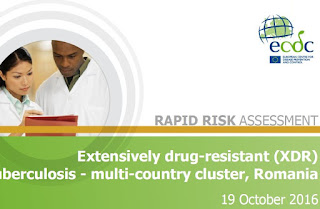#11,832
XDR or Extremely Drug Resistant TB is a rare, but growing form of Tuberculosis that is much harder to treat than the more common MDR (Multi-Drug-Resistant) TB. The WHO describes XDR-TB as:
XDR-TB involves resistance to the two most powerful anti-TB drugs, isoniazid and rifampicin, also known as multidrug-resistance (MDR-TB), in addition to resistance to any of the fluoroquinolones (such as levofloxacin or moxifloxacin) and to at least one of three injectable second-line drugs (amikacin, capreomycin or kanamycin).
This severely restricts treatment options and reduces the likelihood of a cure. The CDC's XDR-TB FAQ states:
Some TB control programs have shown that cure is possible for an estimated 30% to 50% of affected people. Successful outcomes depend greatly on the extent of the drug resistance, the severity of the disease, whether the patient’s immune system is weakened, and adherence to treatment.
While still rare, XDR-TB has been detected in 100 countries around the world, and it - like other antimicrobial resistant organisms - represents a serious and growing threat to public health.
Today the ECDC has published details, and a Rapid Risk Assessment, on a cluster of XDR-TB cases in Romania, which has now spread to two other countries (UK & Israel).
Romania has one of the highest rates of TB in the EU (79.7 per 100K), which is roughly 6 Xs higher than the EU average of 12.8 per 100K population (see the ECDC's Tuberculosis surveillance and monitoring in Europe 2016).
Below you'll find excerpts from today's RRA. Follow the link to read the full report.
Rapid risk assessment: Extensively drug-resistant tuberculosis – multi-country cluster, Romania, 19 October 2016
Main conclusions and options for response
A cluster involving four cases of extensively drug-resistant tuberculosis (XDR TB) has been detected in three students attending the University of Medicine and Pharmacy in Oradea Municipality, Bihor County, Romania. A contact case has also been diagnosed.
The three cases are students in the same year of study. The presumed index case is an Israeli citizen, who was a student in Romania, and was diagnosed in Israel in June 2015. Two of the cases are UK residents who attended the university in Romania as students; one was diagnosed in Romania in October 2015 (case 2) and the other was diagnosed in the UK in September 2016. An additional case has been diagnosed in a family contact of case 2 in the UK. Contact tracing identified 87 contacts who had had exposure, putting them at risk of developing XDR TB disease.
These cases are being followed up to identify and adequately treat active TB cases among them as well as testing for latent tuberculosis infection (LTBI) using tuberculin skin tests (TST). Contacts identified with LTBI may receive preventive treatment depending on the drug susceptibility profile of the XDR TB strain and they should be closely monitored with clinical observation to ensure early detection of XDR TB and to prevent further transmission.
More cases may be expected in association with this cluster. It will therefore be important to trace all contacts of any such additional cases in order to identify and treat active cases and provide preventive treatment or monitoring for those diagnosed with LTBI.
(SNIP)
ECDC threat assessment for the EU
The Mycobacterium tuberculosis strain identified in the cluster associated with the University of Medicine and Pharmacy in Oradea Municipality, Bihor County, Romania has caused XDR TB in three university students and a contact. Infected persons who do not present with symptoms of TB are not infectious. However, they are at risk of developing active TB disease and becoming infectious. The lifetime risk of reactivation TB for a person with documented latent TB infection (LTBI) is estimated to be 5 to 10%, with the majority developing TB disease within the first five years after initial infection [4]. Current contact tracing activities should mitigate the risks of further transmission. However, more cases may be identified through ongoing or future contact tracing.
Conclusions and options for response
More cases may be expected in association with this cluster. It will therefore be important to trace all contacts of any such additional cases in order to identify and treat active cases and to provide preventive treatment or monitoring for those diagnosed with LTBI.
